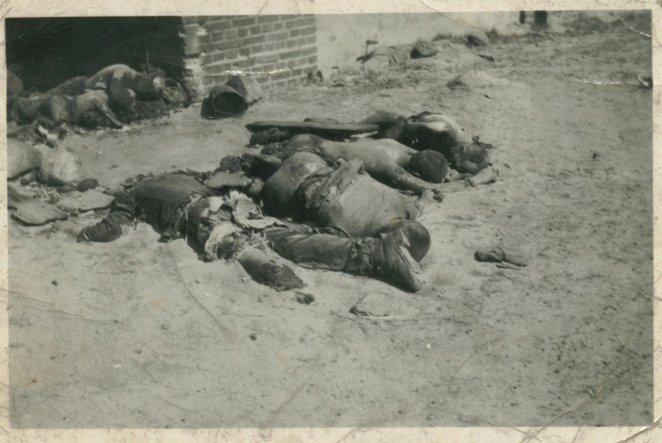Gardelegen Massacre, 13 April 1945 The following account, based on a report written by Col. Edward Cruise after an investigation by the U.S. Army, describes what happened on April 13, 1945 at Gardelegen when 1016 concentratio camp prisoners were burned in a barn or shot while trying to escape. It was written by Karel Margry, the Editor of After the Battle magazine, and published in 2001. This issue of After the Battle, No. 111, is still available. Here is the contact information: After the Battle About 1600, the guards at the Remonte Schule formed up the some 1,050 prisoners in groups of 100 and columns of five. Then, in the late afternoon, they marched them out of the gate and up the road to the north in three large groups of about 300. Those too weak to march, about 100, followed in three carts and trailers drawn by horses and tractors. Somehow, the Germans had assembled some 80 guards: 30 SS men, some of them with dogs; the 18 Kapo guards; half a dozen members of the Volkssturm and of the Reichsarbeitsdienst (Reich Labour Service); and 30 Luftwaffe soldiers from the nearby airfield. The march column was commanded by 58-Hauptscharführer Teply; Transportführer Brauny did not go to the barn (he disappeared from the Remonte Schule sometime during the 13th); what his colleagues Rose and Locke did is unclear. None of the prisoners had any inkling of the fate that awaited them. Rumours had it that they were being marched out to be handed over to the Americans. Guards told some of them that they were going to spend the night in a barn because of lack of space in the barracks. It was less than two kilometers to the barn. When halfway, the column stopped on the road for about an hour. A tractor passed by with several cans of petrol and a case of ammunition. From afar, prisoners saw some of the load being carried inside the barn. The last group of 300 arrived at the barn around 1900 hours. It was still daylight. Here, the 80 guards were joined by some 20 Fallschirmjager, two of them on motorcycles, who arrived carrying Panzerfausts, machine pistols, hand-grenades and flare pistols. The prisoners on foot waited outside the barn for the carts with the sick to arrive, who were put inside first. An Allied aircraft was at that moment circling overhead, so when Unterscharführer Braun (one of the Jlfeld NCOs) ordered the others to move inside as well, many thought it was because of this. As the guards herded them in, a Fallschirmjager soldier fired his machine pistol into the group to make them move faster, wounding one man. All entered through the south-west door. It was now 2000 hours. Once inside, many immediately noticed the strong smell of petrol, but contented themselves with the thought that the barn must have been used as a garage or to store fuel. The prisoners were ordered to sit down. The four big doors were closed and wedged fast on the outside with stones. A few minutes later, the door on the south-west side opened and two soldiers entered. One of them, identified as Braun by some, set fire to the straw with a match at several places. As soon as they had gone out, the prisoners rushed up and frantically put out the flames with their blankets, clothes and bare hands. Then they pushed all the straw to the middle of the barn. The soldiers re-entered and again ignited the floor by discharging the signal flares into the straw. Several times, the prisoners managed to put the fires out but finally the soldiers prevented them by throwing hand-grenades, shooting Panzerfausts. and firing machine pistols and rifles into the frantic masses through the south-west door. The men inside reeled back. Others rushed sideways, pressing themselves against the barn wall to find protection against the bullets. A group of some 50 or 60 Russians rushed to the opposite side of the building. The north-west door was broken open and the prisoners started to run out. The Fallschirmjager mowed them down with machine pistols and rifles. Two machine guns had been placed at the west side of the barn, one covering the northern and one the southern doors. Several of the armed prisoners, notably Kazimierz Drygalski, a Pole, and Adolf August Pinnenkämper, a German, joined in the killing, as did the crew of a nearby Flak battery, Hitlerjugend teenagers led by Wachtmeister Georg Bensch, who came running up with machine pistols. Soon dead and dying men were piling up at all the doors. Cries of pain and panic rung inside the dark building, as others were trampled. To escape the rain of bullets, some men feigned death or hid under the dead bodies of others. By now the fire was completely out of control. The inside of the barn began to fill up with a suffocating smoke. Chaos and panic was complete. Men were swearing, crying, pleading, praying, shouting "Vive Ia France" and "Long live Poland." Several even broke out singing their national anthem. Men were being roasted alive. Human torches ran around until they dropped to the ground dead. Others suffocated or were killed by the exploding hand-grenades and Panzerfausts. [....]
Germans forced to see the barnGermans forced to construct cemeteryCeremony at the cemeteryPrisoners who escapedGerhard Thiele ordered the massacreOld Photos contributed by soldiersOld Photos contributed by Ethel B. StarkText of Memorial Site PamphletPamphlet made by 102nd DivisionHome |